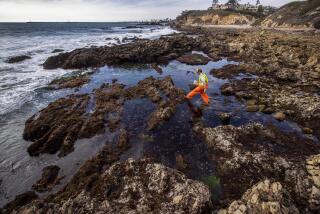Shell may be ready for the Arctic, but its oil spill barge isn’t
SEATTLE — A unique ice-class barge designed to clean up any oil spills that might result from Shell Alaska’s upcoming operations in the Arctic Ocean has so far failed to acquire final U.S. Coast Guard certification. Engineers from the oil company say it’s no longer appropriate to require them to meet the rigorous weather standards originally proposed.
Further, sea trials for the Arctic Challenger — a 37-year-old barge undergoing a multimillion-dollar retrofit — have been delayed in Washington state as federal inspectors insist on improvements to electrical, piping and fire protection systems, a senior Coast Guard inspector confirmed Thursday.
The delay in certification adds another notch of uncertainty to Shell’s narrow window for operations in the Arctic, which already is tight because drilling must halt by September in the Chukchi Sea and by October in the Beaufort Sea to avoid the dangerous advance of sea ice that comes with winter. Though drilling initially was scheduled to commence by mid-July, unusually heavy sea ice from the past winter has postponed that, probably until the first week of August.
The federal Bureau of Safety and Environmental Enforcement has said it will not issue final drilling permits until the Arctic Challenger receives final Coast Guard certification.
Both of Shell’s drilling rigs set sail for Alaska in late June, and federal officials last week conducted successful tests of a specially designed capping stack designed to control a blowout. Only the Arctic Challenger remains stuck in Washington state awaiting Coast Guard approval.
The 294-foot barge, being revamped by Superior Energy Marine Technical Services in Bellingham, Wash., is designed to carry an array of sophisticated containment equipment that would collect spilled oil, separate it, flare off any natural gas and pump the remainder onto a storage tanker for removal. It would be deployed in the event that a blowout preventer or a capping device failed to completely halt the flow of oil from a failed well.
A difference in standards
Coast Guard officials said Shell Alaska had initially received approval for the vessel in December under a stringent set of structural standards based on the American Bureau of Shipping’s standards for floating production installations. Since then, they said, Shell engineers have said they believe the company should be held to the less rigorous standards for mobile offshore drilling units.
The difference, said Coast Guard Cmdr. Christopher O’Neil, is in the strength of storms the vessel can withstand.
“Because of the intended use of the Arctic Challenger and the harsh conditions experienced by maritime traffic in the Arctic, the Arctic Challenger is required to be able to withstand the forces generated by a 100-year storm. The operators of the Arctic Challenger contend that the 100-year standard is too stringent of a design standard, and that a 10-year [storm] standard is more aligned with historical conditions for the area of the Arctic they intend to operate [in] this summer,” O’Neil, who is chief of media relations for the Coast Guard, said in an email to The Times.
Coast Guard officials also have identified several other “issues” with the vessel that they are ordering corrected before certification can occur.
These include the fire protection system, including measures necessary to contain the effects of a fire and aid the possibility of personnel escape; questions about how the emergency generator is connected to the switchboard; and couplings on the piping system that had to be reengineered.
A source familiar with the reconstruction, who spoke on the condition of anonymity because he was not authorized to discuss it, said the problems with the piping system entailed a three-week delay because the entire system had to be pulled out and reinstalled with more robust couplings.
Problems not irreversible
Coast Guard officials said the inspection problems found so far can likely be corrected and that they expect the ship to eventually meet their rigorous standards for deployment in the often-harsh conditions of the Beaufort and Chukchi seas.
“As you do during any modification or new construction process, you’re going to find some issues,” said John Dwyer, an official with the Coast Guard’s inspection division in Puget Sound, which oversees the shipyards in Bellingham.
“Some of the issues are substantive, and although I don’t consider them to be really unexpected or terribly intractable, they are serious and do have to be done before the vessel can leave.”
Shell Alaska officials said they are working closely with the Coast Guard to resolve the remaining issues and that the company will be able to do so with no additional delay in drilling operations.
“We appreciate the Coast Guard’s collaboration in this effort, as we are only interested in deploying world-class assets that can execute flawlessly,” Shell spokesman Curtis Smith said in a statement to the Los Angeles Times.
“We have every confidence the Arctic Challenger will achieve the certifications necessary and that it will be available in the Arctic in 2012,” Smith added. “Because a system like this has never been built for the Arctic, it’s natural that modifications will be made along the way.”
Shell officials say the systems aboard the Arctic Challenger are part of the company’s “tertiary” response and not specifically required by federal regulation. They would be deployed only in the unlikely event that the well’s built-in blowout preventer failed, and then the capping stack failed to completely check the resulting flow.
But Nicholas Pardi of the Bureau of Safety and Environmental Enforcement said the containment system is part of the company’s approved oil spill response plan, and the company is required to get it certified by the Coast Guard before drilling permits can be issued. “We need a positive test on the containment system as one of our conditions,” he said.
Environmental concerns
Critics of offshore drilling in the Arctic have long argued that harsh, unpredictable weather can be a hazard to oil operations even during the summer months, and they questioned any move to hold Shell’s drilling vessels to anything but the strictest structural standards.
“Of anyplace in the world where you don’t want to be hoping for the best, it’s the Arctic Ocean,” said Holly Harris, an attorney for Earthjustice, the environmental legal group that has filed lawsuits in the past challenging offshore Arctic oil operations.
“The folks in Barrow, Alaska, have temperatures below freezing 320 days a year. The average temperature in September is roughly 30 degrees. And the storms are so unpredictable that to sort of … hope the big storm doesn’t come is frankly irresponsible,” she said.
O’Neil said suggestions that the vessel be prepared only for the equivalent of a 10-year storm appear to be an attempt by Shell to steer the certification process to “within the world of the possible and the world of the reasonable.”
Dwyer said he expects that Shell engineers will be prepared next week to discuss a variety of options that will make it safe to operate the Arctic Challenger in adverse weather conditions, even if the original structural standards are not required. This could include the ability to shut down operations and move away or evacuate the vessel in the event of an approaching storm, he said.
“We’re going to continue to apply the standards as originally proposed unless they offer up some operational equivalents,” he said. “We’ll have to see what Shell submits to us.”
ALSO:
Florida lifeguard is fired for saving a life; uproar ensues
Michael Johnson says slave descendants make better athletes
Utah mayor puts handelbar mustache to a vote: Save it? Shave it?
More to Read
Sign up for Essential California
The most important California stories and recommendations in your inbox every morning.
You may occasionally receive promotional content from the Los Angeles Times.










